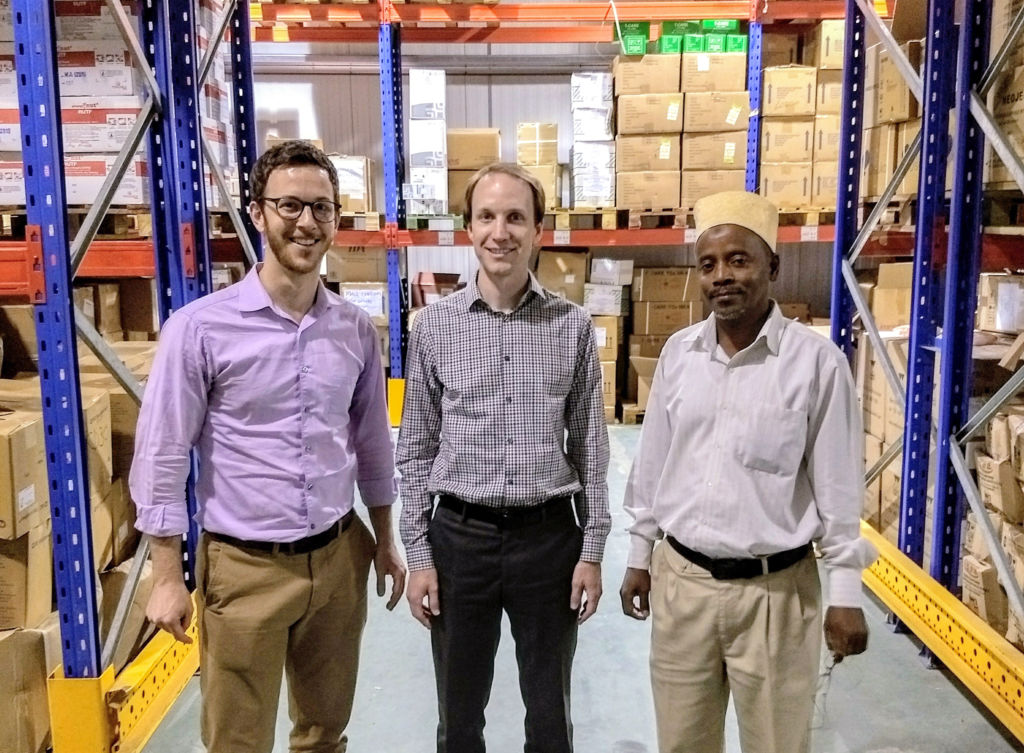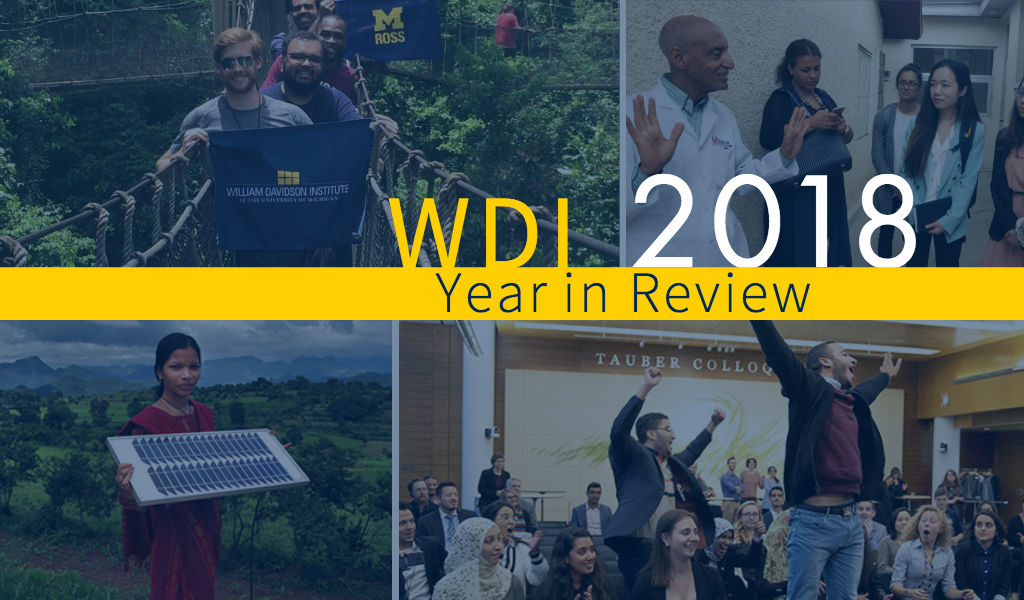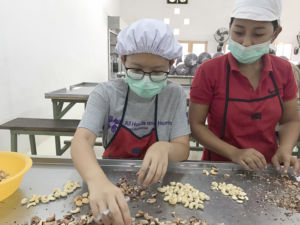This article provides an understanding of the evolution of health product supply chains in developing countries over the past 25 years, and highlights areas where market-oriented reforms have succeeded or failed in improving supply chain performance.

WDI’s Michael Krautmann (left), Ben Davis (center) and manager of a medical commodities warehouse in Zanzibar.
The Global Health Supply Chain Technical Assistance (GHSC TA-TZ) project, funded by the U.S. Agency for International Development (USAID), aims to strengthen Tanzania’s health supply chain systems across different disease programs.
Two research managers from WDI’s Healthcare focus area, Michael Krautmann and Ben Davis, conducted a midterm review of this project to assess whether it is on track to meet its objectives, and also to make recommendations for any necessary course-correcting actions.
GHSC TA-TZ marks a fundamental shift in USAID’s approach to health supply chain technical assistance in Tanzania. Previous projects, such as Supply Chain Management System (SCMS) and USAID | DELIVER Project, focused significant resources on strengthening the health supply chain by providing detailed and direct operational support to the government for key supply chain functions. GHSC TA-TZ seeks to move U.S. government-funded technical assistance away from this type of operational role and toward a more strategic, advisory role. Thus, the first two years of GHSC TA-TZ have focused heavily on transitioning certain supply chain management activities to government ownership.
After completing a thorough desk review of relevant documents and developing an overall methodology, Krautmann and Davis traveled to Tanzania to gather information from health supply chain stakeholders. They conducted more than 35 interviews with more than 60 individuals – from government ministry officials to internal project staff and implementing partner representatives. The interviews, which took place in the cities of Dar es Salaam and Dodoma as well as the nearby island of Zanzibar, provided the type of qualitative information not available in existing documents.
“During interviews, we focused on understanding what the project is doing well and what could be improved,” Krautmann said. “And we solicited interviewee expectations for the project’s remaining years. Between the desk review and interviews, we were able to get a holistic picture of the project.”
GHSC TA-TZ operates in a challenging environment. Tanzania is a large, populous country with major infrastructure challenges at the health facility level. Three separate government entities are involved in managing key health supply chain activities, making effective coordination and accountability more difficult and complex to achieve.
“One of the challenges is how to transition health supply chain functions effectively to the government, especially when these functions are split between ministries,” Krautmann said.

Davis and Krautmann with Zanzibar Ministry of Health’s Supply Chain Management Unit.
Despite these challenges, the GHSC TA-TZ has already made significant contributions to key health supply chain performance metrics such as forecast accuracy, facility reporting rates and, most importantly, product availability at health facilities.
As part of the review, Krautmann and Davis provided GHSC TA-TZ project leadership with a list of actionable recommendations for addressing current risks to project success while also facilitating the project’s transition toward a strategic advisor role. The recommendations drew upon the types of business principles that are the foundation of WDI’s approach. Whether the application of lean thinking, developing mutually-reinforcing organizational capabilities, or analyzing the incentive structures within performance-based contracts, their recommendations sought to leverage private-sector and academic knowledge to benefit Tanzania’s public-sector health supply chain.
Krautmann said WDI was well equipped to handle this project.
“Through our prior work we have a broad, strategic view of the global health supply chain landscape, and we also have on-the-ground experience that allows us to operate effectively with government ministry officials,” he said. “Moreover, we have enough experience working with clinic staff on supply chain issues to be able to predict how things will play out when these national-level policies filter down to the clinic level.”

Improving reproductive health supply chains to boost access to family planning products in Mozambique. Educating senior managers from around the Baltics. Helping both investors and enterprises they support better measure impact in Latin America. Creating new MBA-level curriculum for universities in Papua New Guinea.
These partner projects are just a few examples of the work WDI performed around the world in 2018. Working with a robust set of private sector and nonprofit partners on a diverse number of projects, WDI effectively applied business skills in low- and middle-income countries (LMICs) in impactful ways.
In all, WDI teams worked on more than 40 projects with more than 40 partners in more than 40 countries this past year that focused on our core consulting sectors—education, energy, finance and healthcare, as well as our management education programs, entrepreneurship development, measurement and evaluation services and the deployment of University of Michigan graduate students around the world.
“In 2018, I was impressed by the degree to which the Institute integrated the energy and talents of our staff, University of Michigan students and faculty leaders to address multiple challenges facing for-profit and non-profit organizations,” said WDI President Paul Clyde. “While most of these projects were in one of our key focus areas—Energy, Healthcare, Management education or Finance—many drew on expertise that cut across sectors or disciplines to deliver more complete solutions.”
WDI’s project work leveraged the knowledge and expertise of the Institute’s staff, its research fellows and faculty from the University of Michigan and other world-class higher education institutions to develop business solutions in LMICs. Additionally, WDI disseminated what it learned doing work in the field through published research reports, academic journal articles and notable blog posts. The Institute also contributed to U-M student and faculty enrichment by hosting several compelling speakers at the Ann Arbor campus.

Members of the LIFE project consortium visit a produce stand in Turkey and interviews the owner on how a green grocer sources his produce and his perspective on how he could potentially benefit from the LIFE Food Enterprise Center.
Our work in 2018 spanned the globe and included projects on a wide variety of topics and issues. Among the work, WDI launched a new consulting focus area in the energy sector, connected hundreds of students using virtual technology, developed a model to train nurses for a planned hospital in Ethiopia and trained refugees in the food industry in Turkey. Here are a few highlights from our project work this past year.
Throughout the past year, WDI has widely shared its research and field work a to a broader audience through a number of publications and online journals.
“Participating in the project to test the framework provided us a holistic understanding of poverty. WDI gave us the tools to guide decision-making and track progress towards broader development goals through data collection and analysis.”
—Mónica Varela, director of impact for the Clinton Giustra Enterprise Partnership

WDI intern Nadia Putri (pictured left)
A number of WDI employees penned blogs on their work or trends impacting their research that appeared on the Institute’s website.
In 2018, WDI hosted speakers as part of the the Institute’s Global Impact Speaker Series. While on campus, many of the speakers sat down for one-on-one interviews.

In sub-Saharan Africa, the private sector is a common provider of family planning solutions, used by almost 40 percent of women in the region. But this isn’t the case in Malawi.

Andrea Bare

Erika Beidelman
To find out why, we spent two weeks in-country this past September, exploring Malawi’s private sector landscape for family planning and reproductive health commodities through work sponsored by the Reproductive Health Supplies Coalition’s Innovation Fund, in a project titled “Total Market Approach: Private Sector Distributor Landscape Analysis.” This project is a part of larger efforts to expand access to contraceptives by utilizing the private sector in Malawi (and countries like it) that have historically been dominated by donor-funded commodities. This work will seek to develop recommendations on how the private sector may be expanded in settings like Malawi.
Accompanied by a local pharmacist, we were able to engage in conversations with wholesalers, private retailers, social marketing and faith-based organizations, manufacturers and government representatives, allowing us to gain a “total market” view of Malawi’s current family planning provision. Through this, we witnessed a family planning market dominated by free, public-sector products, alongside a capable yet under-utilized private sector. During our many conversations with key stakeholders in the country, we observed five crucial environmental and policy-related factors that may be directly contributing to the private sector’s ability (or lack thereof) to provide family planning commodities. While we saw this in our visit to Malawi, it may apply to other countries with long histories of donor-funded healthcare.
Malawi has a population greater than many of its African neighbors, including Zambia and Zimbabwe, yet it represents a challenging market. In 2017, the World Bank estimated that 83.2 percent of Malawi’s population lives in rural and hard-to-reach areas. And World Bank measures from 2016 estimated that over 50 percent of the population lives below the national poverty line. These combined factors show that only a limited portion of the population may actually have the ability to pay for and access contraceptives provided in the private sector. Low levels of visible demand for family planning may then prevent private sector actors from investing more into the provision of these products.
All Malawians, regardless of ability to pay, are able to acquire their contraceptives free-of-charge in the public sector – or for a very modest service fee from NGOs and faith-based organizations. This severely limits the private sector’s ability to attract customers for family planning products, even among those who do have the ability to pay. Additionally, all of Malawi’s public sector family planning commodities are donated to the country through larger procurement entities like USAID and UNFPA, which often source each contraceptive product from a single manufacturer. This means Malawi is greatly impacted by global product shortages – as illustrated by the widespread shortages of Depo-Provera that we saw and heard about during our travels. And because the private sector market is not well-developed for these critical products, there may not be a back-up option for women when the public sector is experiencing stock-outs, particularly in the rural areas of the country.
Perhaps due to the public sector’s free provision of family planning, the primary health insurance schemes in Malawi do not include contraceptives as a covered service. This challenge, also evident in other countries, may work to force Malawians (even those with an ability to pay) to use the public sector, because they cannot get a portion of their services covered by their insurance. On a visit to one of Lilongwe’s well-regarded private clinics, the sole gynecologist described how even his regular patients seek their contraceptives from public clinics rather than pay out of pocket.
While speaking to wholesalers across Lilongwe, we found reports of retailers charging up to 100-200 percent margins on many products, including family planning. No regulations currently exist to limit the sometimes-excessive margins that private sector retailers are prone to charging. Exorbitant prices may then work to place the private sector as only a “last resort” outlet for many products. The underlying cause of high margins may be pharmacy operating costs, such as the challenge we heard regarding the difficulty of retaining skilled pharmacists, a profession in relatively short supply in Malawi.
Poverty rates and donor presence lead to cautious manufacturer views on the private market opportunity for contraceptives. We heard concerns that contraceptive manufacturers may perceive that the costs of bringing products to Malawi are greater than the potential market returns – significantly reducing the contraceptives available for wholesalers to supply. A focus on the development of funded demand by government and NGO players may help to incentivize the private sector to bring product to the Malawian market. To take one example, the Malawi government’s “Buy Malawi” campaign, which prioritizes medicine purchases from local manufacturers (for a selection of products), could help ensure a market – if manufacturers were to invest in local production capacity. With appropriate methods of demand generation and market segmentation, Malawi has the opportunity to achieve the same market appeal as some of its neighbors.
Despite these barriers, we noticed that many actors within Malawi’s private sector (both wholesalers and retailers alike) are ready, willing and able to provide contraceptive products when a strong market need is evident. For example, within Malawi’s public sector it can be difficult for women to access emergency contraception due to stock-outs, stigma or long travel and wait times. The private sector has responded through a consistent supply of emergency contraception, with at least three wholesalers providing it, and two more currently working on registering the product for sale in the country. Retailers and wholesalers perceive emergency contraception as a fast-moving product with tremendous market opportunity. Here we can see that when free product is not at the forefront, the private sector has the ability to step in and fill the gap.
If development efforts wish to prepare countries and their private sectors for eventual reductions in global funding, we need to focus more attention on how past (and current) development efforts may inhibit the private sector from fully developing and serving populations that are able and willing to pay.
Andrea Bare is a Senior Advisor with the William Davidson Institute at the University of Michigan.
Erika Beidelman is a Research Associate for the Healthcare sector at WDI.
This article was originally published on NextBillion.net, which is managed by WDI.
In this project, funded by the Bill & Melinda Gates Foundation, WDI helped adapt a “capabilities-system” framework from the private sector for use with a low- and middle-income (LMIC) health supply chain. The work was designed to address a gap between some country government initiatives meant to improve the efficiency and effectiveness of health supply chains that have been successful and others that have not shown significant benefit. Potential causes for this limited impact include a lack of coherence across the initiatives and a disconnect between the initiatives and a country’s overarching public health and health supply chain objectives. By applying this framework, the organizations expect greater overall coherence across projects in a health supply chain improvement initiative as well as with overarching public health and health supply chain objectives. This is expected to lead to greater long-run health supply chain efficacy and efficiency in LMICs.
Through this Bill & Melinda Gates Foundation funded project, WDI helped build alignment and a clear vision among donor agencies, governments and private companies regarding supply chain investments that must be made now to prepare for future changes in healthcare demand. These investments are driven by a convergence of trends in technology, innovation, economic growth and shifting disease burdens. WDI helped provide this clear vision through a number of different research avenues:
Through these various approaches, WDI successfully started a global conversation about the need for more future-oriented supply chain investments.
WDI’s project goal for this project was to provide buyers with a structured way of evaluating and negotiating potential investments related to the manufacturing of specific vaccine presentations. WDI hypothesized that it could facilitate negotiations between buyers and manufacturers of vaccines by developing a flexible tool that incorporates their respective investment decision drivers and key levers related to price and value. The outcome of this work, funded by the Bill & Melinda Gates Foundation, is increased availability of vaccines in low- and middle-income countries.
In this Bill & Melinda Gates Foundation funded work, WDI assisted the government of Togo in identifying and addressing performance bottlenecks in the public-sector health supply chain. WDI assessed the current operations of the Togolese health supply chain across a wide range of functions, products and health system levels. WDI identified root causes for the last-mile stock out of essential medicines and validated these root causes during a meeting convening 50 high-level local stakeholders. WDI then developed a clear process and strategic framework for designing and implementing activities to address root causes. This project provided the government of Togo with the evidence and tools needed to make significant improvements to the public-sector health supply chain. Moreover, many aspects of WDI’s engagement – from the use of management consulting-based strategic frameworks to research on capabilities of private pharmaceutical wholesalers – helped to lay a foundation for supply chain improvement activities which are driven by private sector principles and lead to market-oriented solutions.
WDI extensively reviewed literature, conducted interviews with in-country stakeholders and consulted with cross-sector supply chain experts to develop a report that provided recommendations for strengthening Senegal’s health supply chain, specifically in regard to last-mile delivery. WDI also delivered recommendations for better incorporating service to the last mile in the national health supply chain strategy. Senegal faces several challenges to ensuring that existing health supply chain continues to expand its reach, product range and quality of service. Several initiatives to improve the function and reach of the health supply chain have been implemented over the previous decade, including the “Informed Push Model,” which has achieved notable success at increasing product availability at the “last mile.”
WDI developed an approach and toolkit to help governments and donor agencies manage complex data and conflicting priorities when evaluating supply chain designs, and an approach for quantifying the priorities of individual stakeholders and then using those priorities to weight the observed performance of a supply chain model. Drawing upon academic and industry research in multi-criteria decision analysis, this approach resulted in a simplified, composite performance metric that enabled easy comparison across different supply chain models and stakeholders. By applying this approach retrospectively to health supply chain pilot analyses in Zimbabwe, Tanzania, Nigeria and Togo, WDI increased government and donor awareness of the true diversity of real-world stakeholder priorities and highlighted the importance of addressing such priorities in the performance management process. This project was funded by the Bill & Melinda Gates Foundation.